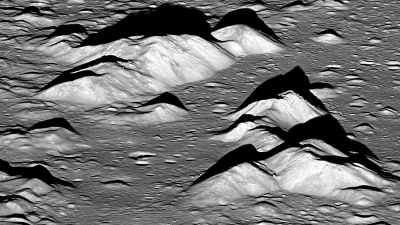
Planetary scientists from Brown University have developed a new remote sensing method for studying olivine, a mineral that could help scientists understand the early evolution of the Moon, Mars and other planetary bodies.
“Olivine is understood to be a major component in the interiors of rocky planets”, said Christopher Kremer, a PhD candidate at Brown University and lead author of a new paper describing the work. “It’s a primary constituent of Earth’s mantle, and it has been detected on the surfaces of the Moon and Mars in volcanic deposits or in impact craters that bring up material from the subsurface.”
Current remote sensing techniques are good at spotting olivine from orbit, Kremer says, but scientists would like to do more than just spot it. They’d like to be able to learn more about its chemical makeup. All olivines have silicon and oxygen, but some are rich in iron while others have lots of magnesium.
Olivine (greenish crystals) is thought to be one of the most abundant minerals in interior of the Earth and other planetary bodies.
“The composition tells us something about the environment in which the minerals formed, particularly the temperature”, Kremer said. “Higher temperatures during formation yield more magnesium, while lower temperatures yield more iron. Being able to tease out those compositions could tell us something about how the interiors of these planetary bodies have evolved since their formation.”
To find out if there might be a way to see that composition using remote sensing, Kremer worked with Brown professors Carlé Pieters and Jack Mustard, as well as mountains of data from the Keck/NASA Reflectance Experiment Laboratory (RELAB). RELAB makes high-precision spectral measurements of samples for which the composition is already determined using other laboratory techniques. By doing that, the lab provides a ground truth for interpreting spectral measurements taken by spacecraft looking at other planetary bodies.
“Over the past few decades, there’s been a lot of interest in near infrared spectroscopy and middle infrared spectroscopy”, Kremer said. “But there’s a small range of wavelengths between those two that’s left out, and those are the wavelengths I was looking at.”
Kremer found that those wavelengths, between 4 µm and 8 µm, could predict the amount of magnesium or iron in an olivine sample to within about 10 % of the actual content. That’s far better than can be done when those wavelengths are ignored.
“With the instruments we have now, we could say maybe we have a little bit of this or a little bit of that”, Mustard said. “But with this we’re able to really put a number on it, which is a big step forward.”
The researchers hope that this study, which is published in Geophysical Research Letters (doi.org/fhq5), might provide the impetus to build and fly a spectrometer that can measure these wavelengths. Such an instrument could pay immediate dividends in understanding the nature of olivine deposits on the Moon’s surface, Kremer says.
“The olivine samples brought back during the Apollo programme that we’ve been able to study here on Earth vary widely in magnesium composition”, Kremer said. “But we don’t know how those differing compositions are distributed on the Moon itself, because we can’t see those compositions spectroscopically. That’s where this new technique comes in. If we could figure out a pattern to how those deposits are distributed, it could tell us something about the early evolution of the Moon.”
The research was supported through NASA SSERVI (NNA14AB01A) and a NASA FINESST grant.


